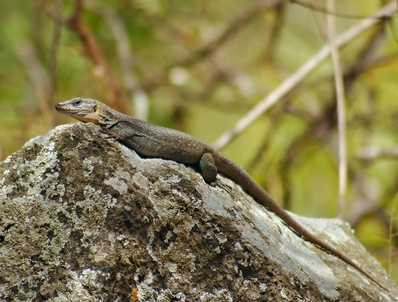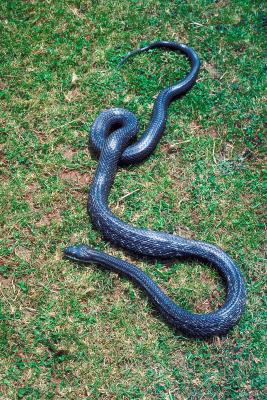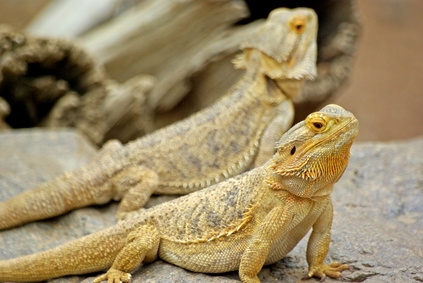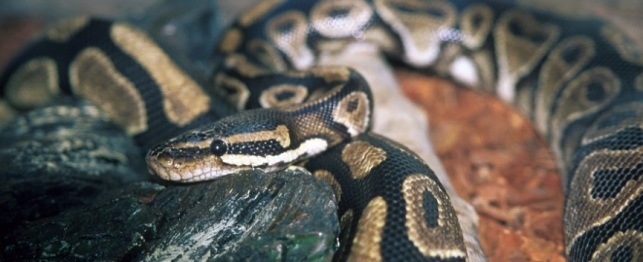
DIY Water Dragon Enclosures. Chinese water dragons are some of herpetology's most interesting animals. Water dragons are enormously popular in the pet trade, mostly due to their disposition and ease of care. For someone who is serious about keeping a happy water dragon as a pet, one of the best things you can do is build an enclosure that will keep your lizard happy. To do this properly, you need to know a few things about basic reptile cage construction and a few things about the water dragon as a species.

Decide on the size you want the enclosure to be. If you don't want to have to make another cage in the future, choose a size that will be suitable for the fully grown adult. A good size is 6-feet long x 3-feet deep x 5-feet high, as male water dragons can reach 3-feet long.
Cut plywood for the back and sides of the enclosure, and Plexiglas for the front and bottom using a hand saw or shop saw if you have one available. Leave the top open. Attach the sides with screws (if you have a drill sharpened for Plexiglas), or you can use a nontoxic sealant or glue to attach. Let the glued sides dry completely (time will depend on amount used and brand -- reference the instructions for that particular sealant), and test for strength by pushing on the sides from the inside of the cage to ensure that your dragon won't break out.
Create a lid made out of wire mesh or a similar material. This will allow air flow throughout your cage, which is very important for an animal of this size. It will also allow more unfiltered light to enter. Take a piece of mesh a little bit larger than the actual top of the cage and bend the corners down to fit over the cage. You can then attach pieces of wood or metal with staples so you don't have to grab the sharp edges. Your lid should now lift up and fit on with ease.
Place a cat litter pan or a similarly sized plastic pan on one side of the tank and fill with fresh, room temperature water. Using a plastic pan will make it easier to clean when dirty.
Fill the rest of the tank with a few inches of substrate, enough to be level with the water dish at the other end. A good substrate starting material is a mixture of sterile soil and play sand. Do not use any soil with plant food or fertilizers, which are toxic to the dragon.
Add in some large branches for your dragon to climb on. Soak the branches in a mild bleach solution (1 part bleach to 9 parts water) for four hours to kill any parasites, then rinse and let dry completely before adding them to the cage. Mix the bleach solution in a bucket large enough to totally submerge the branches or do half, then flip after four hours and do the other half.
Place a florescent UVB basking light in the cage about 10 inches to 12 inches above the substrate, and place a basking rock underneath it. This may hang from the lid or from a stand inside the cage. Basking in UVB is essential to the calcium absorption of the dragon. You may need to create a protective cover of wire mesh for the light if it is where the dragon could reach it and burn himself. To do this, bend a piece of wire mesh around the hot part of the light, an inch or two off the bulb, and secure it to the non-heated part of the light with tape or another adhesive.
Add the other heat sources for your cage. You could use an under tank heater, a ceramic heat lamp, a normal heat lamp or a combination of these. Under tank heaters will be duct-taped to the bottom of the terrarium, whereas lights will sit on the mesh lid. This will require some experimentation to find out what works for you and your pet. Use a thermostat to regulate the temperature of your chosen device(s). Follow the instructions on the thermostat to attach it properly. A good daytime temperature for a water dragon is about 84 degrees to 88 degrees Fahrenheit, and nighttime temperatures should be between 75 degrees and 80 degrees.
Place a thermometer on each side of the cage to monitor the temperature across the habitat, and place a hydrometer in the middle to monitor humidity. Most gauge-style thermometers and hydrometers attach via an adhesive patch on the back, which you can stick onto the inside surface of the cage. Water dragon humidity should stay high, over 80 percent if possible. This can be maintained by misting the cage twice daily with a spray bottle full of fresh water.
Add in the food dish to keep the substrate clean and any other cage decorations you have. If you have plants, place them near the Plexiglas sides of the cage as snout damage is very common in these lizards from continuously running into the Plexiglas or glass fronts of aquariums. Fake plants, which can be stuck into the substrate are adequate, or you can use live, nontoxic, reptile-safe plants if you wash away all the pot soil from the roots before planting it in your own soil. Give these plants a good washing all over with water to prevent transmission of parasites.
 What Foods Do Reptiles Eat?
What Foods Do Reptiles Eat?
What Foods
What Foods Do Reptiles Eat?
What Foods Do Reptiles Eat?
What Foods
 How to Care For a Black Rat Snake
How to Care For a Black Rat Snake
How
How to Care For a Black Rat Snake
How to Care For a Black Rat Snake
How
 How to Build Reptile Enclosures
How to Build Reptile Enclosures
How to
How to Build Reptile Enclosures
How to Build Reptile Enclosures
How to
 Choosing a Painted Turtle
Choosing a Painted Turtle
Choosing a Painted Turtle
Choosing a Painted Turtle
 Choosing a Ball Python
Choosing a Ball Python
Choosing a Ball Python
Choosing a Ball Python
Copyright © 2005-2016 Pet Information All Rights Reserved
Contact us: www162date@outlook.com